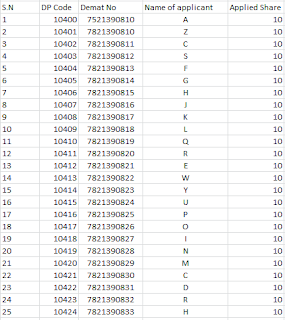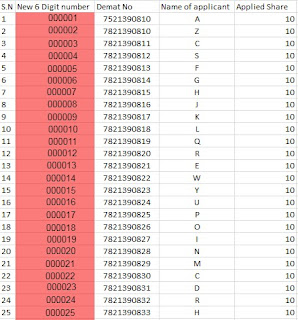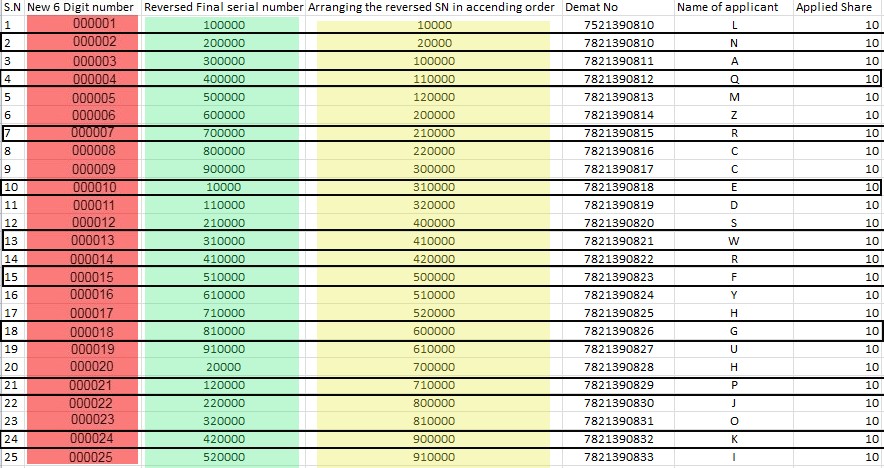We know, how to apply for IPO? We also may know how to check IPO results but many of us don't know how is IPO allotted in Nepal via lottery system?
This is relatively a more technical and complex part of the share market that every investor should know about. There is some math, technology and it holds the luck elements too.
When Initial Public Offering is oversubscribed it is mostly allotted via a lottery system. It is considered the cleanest, impartial, and anonymous way to allot the IPOs and shares in Nepal and other different counties. I think this practice is one of the corruption and partiality-free practice in Nepal.
 |
| How is IPO Allotted in Nepal via Lottery System? |
Before, moving to how is IPO allotted in Nepal via lottery system let's know what is IPO in brief.
What is IPO?
IPO stands for Initial Public Offering. IPO is the share issued by a public limited company for the general public to collect capital by sharing the ownership of the company. A company needs to be approved by SEBON after meeting certain criteria for issuing IPO.
There was a time when I used to think about what an IPO is? Is it I for input, P for process, and O for output? Funny Nah! it's not like that it's a different topic but we need to input share value, our luck processes the result and we get output.
Look! how I related the context.
Why is the lottery system used in IPO allotment?
When IPO is oversubscribed and the number of applicants exceeds the number of expected subscribers then a lottery system is used in IPO allotment.
IPO Allotment Process: How is IPO Allotted in Nepal via Lottery System?
IPO is generally allocated in three different steps. All three steps are done in a very sensitive, technical, and intellectual manner. IPO allocation under the lottery system is done in 4 different steps.
Let's consider an example of A&B Group of Company to generalize the concept of IPO allotment.
A&B Group of Company issued 30,20,000 units of share for the general public. Thereafter the IPO announcement 8,35,522 people applied for the IPO. According to SEBON, each applicant must get at least 10 shares. Hence, it is already determined that 3,02,000 applicants will get the share ownership.
Here in the case of A&B Group of Company the shares are oversubscribed so that the IPO of A&B Group of Company will be allotted via a lottery system.
Here I will take the data of the first 25 applicants among 8,35,522 applicants. It will help you better understand and also help me in easy explaining. let's see how the raw data of first 25 applicant looks like. and how we proceed from the raw data to the final data for the lucky draw.
 |
| Raw data of applicants |
Before moving ahead let's know in brief about the Demat account, Demat number, and DP code/BOID number.
- A Demat account is a bank account that is created for the special purpose of trading shares.
- The Demat number is provided by the bank which is a unique 16 digit number.
- DP is a depository participant which is similar to the bank code which denotes your connection to your DP.
- BOID is a Beneficial Ownership Identification Number. It is unique and provides your identity in the share market.
When someone applies for the IPO/share then it is stored in the real-time based sorting in the database. If I applied at 11 am and you applied at 11:01 am then I will be sorted in number 1 and you will be shorted in number 2 in the database. Data that is provided by the share applicants are stored in the database of CDSC and it is further provided to the issue manager by CDSC.
For Impartial allotment, this kind of data is manipulated to destroy the time-based sorting. The first step for IPO allotment in Nepal via a lottery system is data manipulation. This is the finest method by which IPO is allotted in Nepal via lottery system.
Data Manipulation
In the first step, data is manipulated and given a different shape. I will show you how the data differs after the manipulation. This is a little technical and mathematical process but I will do my best to make you better understand. When the data collected by CDSC is transferred to the issue manager then it will manipulate the data and modify it.
There are three steps in data manipulation. Let's start with the first step.
Firstly, form a new number considering the total number of applicants. For example, 8,35.522 applicants applied for the IPO of A&B Company. Count the digits in 8,35,522 there are 6 digits. Hence it means that we have to make 1 digit number also a six-digit number to make equality to all the applicants.
If the number of applicants were 10,00,000 then we will transform all the numbers into 7 digit numbers because there are 7 digits in 10 lakh.
When I apply for IPO first of all my serial number is 1 and when any other apply for IPO last then, his/her serial number is 8,35,522 (in the case of A&B Group of Company). For equality and manipulation, my serial number (1) is also transformed to 6 digit number because there are 6 digits in the serial number of the last applicant.
We can make a one-digit number a six-digit number by adding five zeros in front of the one-digit number. Similarly, we can make a two-digit number a six-digit number by adding four zeros in front of the two-digit number.
Let's see an example that I have made from the data of A&B Group of Company.
 |
| Six-digit number formed |
The highlighted part contains the newly formed six-digit number. We added zeros in front of the serial number according to the need to form a six-digit number.
After forming the six-digit number let's reverse the six-digit number. This is the second step in data manipulation. We can reverse the newly formed six-digit number by rewriting it from the back. For example, to reverse 000002 then I rewrite 000002 from the right that is 2. I get 200000. This is how reversing is done.
After reversing is done the reversed serial number is sorted in ascending order (smaller number to larger). It is the easiest thing that everyone can do. This is the final step in data manipulation. We get a completely unique applicant number which helps in making the IPO allotment fair. If you want to know how is IPO allotted in Nepal via lottery system then read the article till the end.
Let's see the example of how I reversed the six-digit new serial number and sorted it in ascending order.
 |
| Final chart of data manipulation |
The green highlighted area shows the reversed serial number of the applicant and the yellow portion shows the serial number of applicants sorted in ascending order.
Look at the name of applicants. They are now rearranged in an undefined sequence. you can compare the raw data and the manipulated data. When we short the newly formed serial number the position of the applicants also changes. This is how IPO is allotted in Nepal via lottery system by manipulating data. Look at the picture below.
.
After forming the new serial number the first applicant named A in the raw data comes in third place. The applicant named Y which was in the 15th number got the sixteenth number and the applicant of the 16th number which was U. He got the nineteenth number. This is how data is totally modified in undefined series.
Data Analyzing and Finding Skip Value
After we manipulate the raw data we need to analyze the data and find the skip value. If you want to know how is IPO allotted in Nepal via lottery system mind it carefully, this is the most crucial step.
Here A&B Group of Company has issued 30,20,000 units of shares. According to the rule of SEBON, one lucky applicant should get at least 10 units of shares.
Hence,
Number of applicants who get IPO shares = Total issued units of shares divided by 10
We get 3,02,000 as a result of dividing total shares issued by A&B Group of Company by the minimum share that a company must allocate to a lucky applicant.
Here 8,35,522 applications are recorded in the database of CDSC. This means the IPO is oversubscribed by more than two and a half times.
Now it is known that 3,02,000 will only get the IPO shares. To know who are those 3,02,000 among 8,35,522 we have to find skip value.
What is skip value?
Skip value is an expression that evaluates the number of applicants on the list to skip. In other language skip value is the ratio of the total number of applicants and total supported beneficiaries When there is a skip value of 4, it means that one person will get the IPO share among four applicants.How is skip value calculated?
To find the skip value divide the total number of applicants by total supported beneficiaries of the IPO shares. For example, only 3,02,000 applicants of A&B Group of Company can only get the shares. They are the supported beneficiaries of the company and 8,35,522 are the total applicants. We should divide 8,35,522 by 3,02,000. We got the skip value of 2.77.
The skip value of 2.77 means that one person will get the chance to handle the ownership of 10 units of shares among 2.77 people.
Picking up a First Luckiest Applicant
This step is done to choose the first lucky applicant who gets the IPO of the company(A&B Group of Company). Nine balls are kept in a basket. 9 balls are given numbers from 1-9 not repeating any number in a fair way in front of media personnel. The balls are kept in a basket and covered.
 |
| Keeping lottery balls inside the basket |
After keeping the balls inside a covered basket anyone presented in the ceremony is asked to pick up a ball. They may be investors or media personnel.
The random number that comes while picking a ball becomes the first lucky shareholder of the company. Then the number which comes from the basket is used to find the other lucky applicant who gets the IPO of the company.
If number 2 comes when picking a ball from the basket then the investor who is in serial number two will get the IPO of the company first. Then two is added with the skip value to find the rest of the successful investor who gets IPO of the company. This is how the IPO is allotted in Nepal via lottery system.
Finding the Rest Lucky Applicant
To find the rest of the lucky applicants we just need to add the skip value with the number which we get from picking up the ball from the basket.
Since we got number 2 from the basket while picking up, therefore, the applicant in the second number got the IPO. He is N and his Demat number is 7821390810 according to our data.
For other winning applicants the skip value and the ball number are added. If we add skip value 2.77 and ball number 2 then the result is 4.77. We just need to look at the number before the decimal which is 4 then the applicant in the 4th number got the IPO.
 |
| Finding the lucky applicants by skip value |
Likewise, go ahead adding skip value. We got 4.77 before, add 2.77 (skip value) with 4.77. We get 7.54 then here the 7th applicant will get the IPO now. There we get 7.54 and just see the number before decimal which is 7. Hence 7th applicant is allotted 10 units of shares of A&B Group of Company.
Again add skip value to the 7.54 (7.54+2.77) we get 10.31 then look at the number before the decimal which is 10. Now the applicant in serial number 10 is the lucky applicant.
This kind of formula is set in the system and it will automatically carry out the final result and select the 3,02,000 applicants from the manipulated data. Here is shown the lucky draw of 25 applicants in the above picture.
This is how IPO is allotted in Nepal via a lottery system. As this is done with the presentation of the media personnel and predetermined system, there is no doubt of happening fraud and unfair activities.
When you got to know the full process of allocation it becomes easier and comfortable for you to invest if you are just starting your career in the share market.
I think your query for how is IPO allotted in Nepal is now cleared. Thank you for reading the article till the end if you think this is helpful don't forget to drop share with your friend. If you have any think to tell comment box is waiting just below the article.
More from Santosh's Blog





0 Comments
Post a Comment
All the information shared here are the outcome of author's research and experience, they might not be applicable in your particular case. Therefore before applying such crucial matters in your personal life don't forget to understand the acutal sutiation. In the other hand we try to provide genuine, validated and tangible information to you.
Please be polite and don't forget to follow the community guidelines while commenting in the post. We don't allow the spam comments in our blog.